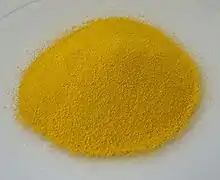Bismuth vanadate
Bismuth vanadate is the inorganic compound with the formula BiVO4. It is a bright yellow solid. It is widely used as visible light photo-catalyst with a narrow band gap of less than 2.4 eV.[1] It is a representative of "complex inorganic colored pigments," or CICPs. More specifically bismuth vanadate is a mixed-metal oxide. Bismuth vanadate is also known under the Colour Index International as C.I. Pigment Yellow 184.[2] It occurs naturally as the rare minerals pucherite, clinobisvanite, and dreyerite.
 | |
| Names | |
|---|---|
| Other names
Bismuth orthovanadate, Pigment yellow 184 | |
| Identifiers | |
3D model (JSmol) |
|
| ECHA InfoCard | 100.034.439 |
| EC Number |
|
PubChem CID |
|
CompTox Dashboard (EPA) |
|
| |
| |
| Properties | |
| BiO4V | |
| Molar mass | 323.918 g·mol−1 |
| Appearance | bright yellow solid |
| Density | 6.1 g/cm3 |
Refractive index (nD) |
2.45 |
| Hazards | |
| GHS pictograms |  |
| GHS Signal word | Warning |
| H373 | |
| P260, P314, P501 | |
Except where otherwise noted, data are given for materials in their standard state (at 25 °C [77 °F], 100 kPa). | |
| Infobox references | |
History and uses
Bismuth vanadate is a bright yellow powder and may have a slight green tint. When used as a pigment it contains a high Chroma and excellent hiding power. In nature, bismuth vanadate can be found as the mineral pucherite, clinobisvanite, and dreyerite depending on the particular polymorph formed. Its synthesis was first recorded in a pharmaceutical patent in 1924 and began to be used readily as a pigment in the mid-1980s. Today it is manufactured across the world for pigment use.[2]
Properties
Most commercial bismuth vanadate pigments are now based on pure bismuth vanadate with monoclinic (clinobisvanite) or tetragonal (dreyerite) structure though in the past two phase systems involving a 4:3 relationship between bismuth vanadate and bismuth molybdate (Bi2MoO6) have been used.[3] In the monoclinic phase, BiVO4 is an n-type photoactive semiconductor with a bandgap of 2.4 eV, which has been investigated for water splitting after doping with W and Mo.[3] BiVO4 photoanodes have demonstrated record solar-to-hydrogen (STH) conversion efficiencies of 5.2% for flat films[4][5] and 8.2% for WO3@BiVO4 core-shell nanorods[6][7][8] (highest for metal-oxide photo-electrode) with the advantage of a very simple and cheap material.
Production
While most CICPs are formed exclusively through solid state, high temperature calcination, bismuth vanadate can be formed from a series of pH controlled precipitation reactions (it is important to note these reactions can be carried out with or without the presence of molybdenum depending on the desired final phase). It is also possible to start with the parent oxides (Bi2O3 and V2O5) and perform a high temperature calcination to achieve a pure product.[9]
References
- Moniz, S. J. A.; Shevlin, S. A.; Martin, D. J.; Guo, Z.-X.; Tang, J. (2015). "Visible-light driven heterojunction photocatalysts for water splitting – a critical review. Energy & Environmental Science". 8: 731–759. doi:10.1039/C4EE03271C. Cite journal requires
|journal=(help) - B. Gunter "Inorganic Colored Pigments” in Ullmann's Encyclopedia of Industrial Chemistry, Wiley-VCH, Weinheim, 2012.
- Kaur, G.; Pandey, O. P.; Singh, K. (July 2012). "Optical, structural, and mechanical properties of different valence-cation-doped bismuth vanadate oxides". Physica Status Solidi A. 209 (7): 1231–1238. Bibcode:2012PSSAR.209.1231K. doi:10.1002/pssa.201127636.
- Han, Lihao; Abdi, Fatwa F.; van de Krol, Roel; Liu, Rui; Huang, Zhuangqun; Lewerenz, Hans-Joachim; Dam, Bernard; Zeman, Miro; Smets, Arno H. M. (October 2014). "Efficient Water-Splitting Device Based on a Bismuth Vanadate Photoanode and Thin-Film Silicon Solar Cells" (PDF). ChemSusChem. 7 (10): 2832–2838. doi:10.1002/cssc.201402456. PMID 25138735.
- Abdi, Fatwa F.; Han, Lihao; Smets, Arno H. M.; Zeman, Miro; Dam, Bernard; van de Krol, Roel (29 July 2013). "Efficient solar water splitting by enhanced charge separation in a bismuth vanadate-silicon tandem photoelectrode". Nature Communications. 4 (1): 2195. Bibcode:2013NatCo...4.2195A. doi:10.1038/ncomms3195. PMID 23893238.
- Pihosh, Yuriy; Turkevych, Ivan; Mawatari, Kazuma; Uemura, Jin; Kazoe, Yutaka; Kosar, Sonya; Makita, Kikuo; Sugaya, Takeyoshi; Matsui, Takuya; Fujita, Daisuke; Tosa, Masahiro (2015-06-08). "Photocatalytic generation of hydrogen by core-shell WO 3 /BiVO 4 nanorods with ultimate water splitting efficiency". Scientific Reports. 5 (1): 11141. doi:10.1038/srep11141. ISSN 2045-2322. PMC 4459147. PMID 26053164.
- Kosar, Sonya; Pihosh, Yuriy; Turkevych, Ivan; Mawatari, Kazuma; Uemura, Jin; Kazoe, Yutaka; Makita, Kikuo; Sugaya, Takeyoshi; Matsui, Takuya; Fujita, Daisuke; Tosa, Masahiro (2016-02-25). "Tandem photovoltaic–photoelectrochemical GaAs/InGaAsP–WO3/BiVO4device for solar hydrogen generation". Japanese Journal of Applied Physics. 55 (4S): 04ES01. doi:10.7567/jjap.55.04es01. ISSN 0021-4922.
- Kosar, Sonya; Pihosh, Yuriy; Bekarevich, Raman; Mitsuishi, Kazutaka; Mawatari, Kazuma; Kazoe, Yutaka; Kitamori, Takehiko; Tosa, Masahiro; Tarasov, Alexey B.; Goodilin, Eugene A.; Struk, Yaroslav M. (2019-07-01). "Highly efficient photocatalytic conversion of solar energy to hydrogen by WO3/BiVO4 core–shell heterojunction nanorods". Applied Nanoscience. 9 (5): 1017–1024. doi:10.1007/s13204-018-0759-z. ISSN 2190-5517. S2CID 139703154.
- Sulivan, R. European Patent Application 91810033.0, 1991.